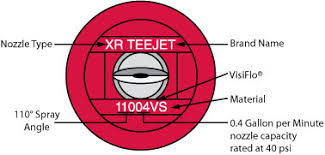Sprayer and Spreader Calibration
Sprayer calibration is the process of ensuring that your spray equipment is prepared to deliver the correct volume of liquid carrier in the proper spray pattern required for the field being treated. In order to avoid improper or wasteful use of herbicides, it is important that proper calibration of application equipment is completed regularly.
Calibration Guide
- Check nozzle operation and spray pattern
- Make sure nozzles are operational & pattern is a good fit for upcoming application
- Determine nozzle output at standard 40psi
- Measure output by spraying water through nozzle for 15 seconds
- Fluid ounces (fl oz) collected can be used to calculate spray rate
- Multiply by 4 to determine fl oz per minute
- Divide by 128 to determine gallons per minute, or GPM (as 128 fl oz comprise 1 gal)
- Repeat this process for all nozzles on sprayer
- Determine tractor/walking speed
- Speed of over specific distance based on nozzle spacing or band width
- Record time required to travel distance to obtain speed, convert to mph
- Speed of over specific distance based on nozzle spacing or band width
- Calculate sprayer output
- Sprayer output in gallons per acre (GPA) obtained by entering values for nozzle output in gallons per minute (GPM), speed (mph), and nozzle spacing (in) into the formula:
- GPA =
- (5940 x GPM) / (speed x sprayer width)
- (5940 x _gal / min) / (_mph x _in)
- GPA =
- Sprayer output in gallons per acre (GPA) obtained by entering values for nozzle output in gallons per minute (GPM), speed (mph), and nozzle spacing (in) into the formula:
- Determine if sprayer output is appropriate for herbicide product
- Consult herbicide label for information regarding appropriate output rate for the recommended mixture of the product
- Changes in sprayer range can be made by recalibrating sprayer
- Large changes in sprayer output can be made by changing nozzle size
- Small changes in sprayer output can be made by changing pressure from the standard 40psi, though doing this will require recalculating nozzle output and sprayer output
- Consult herbicide label for information regarding appropriate output rate for the recommended mixture of the product
- Calculate total spray mixture volume
- Spray mixture volume =
- (sprayer output) x (treated area)
- (_gal / acre) x (_acre)
- Spray mixture volume =
- Determine area covered by one full spray tank
- Treated area covered by full spray tank =
- (sprayer tank capacity) / (sprayer output)
- (gal) / (GPA)
- Treated area covered by full spray tank =
- Preparing spray mixture
- Treated area covered by one full spray tank x herbicide rate from label
- (_gal / acre) x (_oz/pt/gal / acre)
- Scale up for full coverage of treated area if necessary
Example Problems
A quarter acre field infested with yellow nutsedge is to be treated with halosulfuron-methyl (Sandea) in order to prepare for watermelon transplants.
- If your sprayer has nozzles with 18 inch spacing, a nozzle output of .33 gpm and you move at a 3 mph pace, how many gallons per acre of formula can you apply?
- What is the total volume of formula that needs to be applied to this field?
- If the sprayer tank can hold 65 gallons, how much of the field can one tank cover?
- How much Sandea needs to be used in order to treat the field?
A field known to contain seed from a number of highly problematic weeds is to be treated with s-metolachlor (Dual Magnum) in preparation for tomato transplants.
- If your sprayer has nozzles with 20 inch spacing, a nozzle output of .27 gpm and you move at a 2 mph pace, how many gallons per acre of formula can you apply?
- What is the total volume of formula that needs to be applied to this field?
- If the sprayer tank can hold 50 gallons, how much of the field can one tank cover?
- How much Dual Magnum mixture needs to be made to treat the field?
20 acres of land infested with palmer amaranth and common purslane is to be treated with fomesafen (Reflex) in preparation for an upcoming bell pepper planting.
- If your sprayer has nozzles with 21 inch spacing, an average output of .42 gpm and you move at a 2.5 mph pace, how many gallons per acre of formula can you apply?
- What is the total volume of formula that needs to be applied to this field?
- If the sprayer tank can hold 100 gallons, how much of the treated area can one tank cover?
- How much Reflex needs to be added to the tank in order to treat the field?
SOLUTIONS
Nozzle Diagram

References:
Texas A&M AgriLife Extension, Herbicide Sprayer Calibration Worksheet, https://www.advancedturf.com/wp-content/uploads/_3/herbicide_sprayer_calibration.pdf
University of Tennessee Extension, A Simple Method to Calibrate Sprayers, https://extension.tennessee.edu/publications/Documents/W315.pdf




